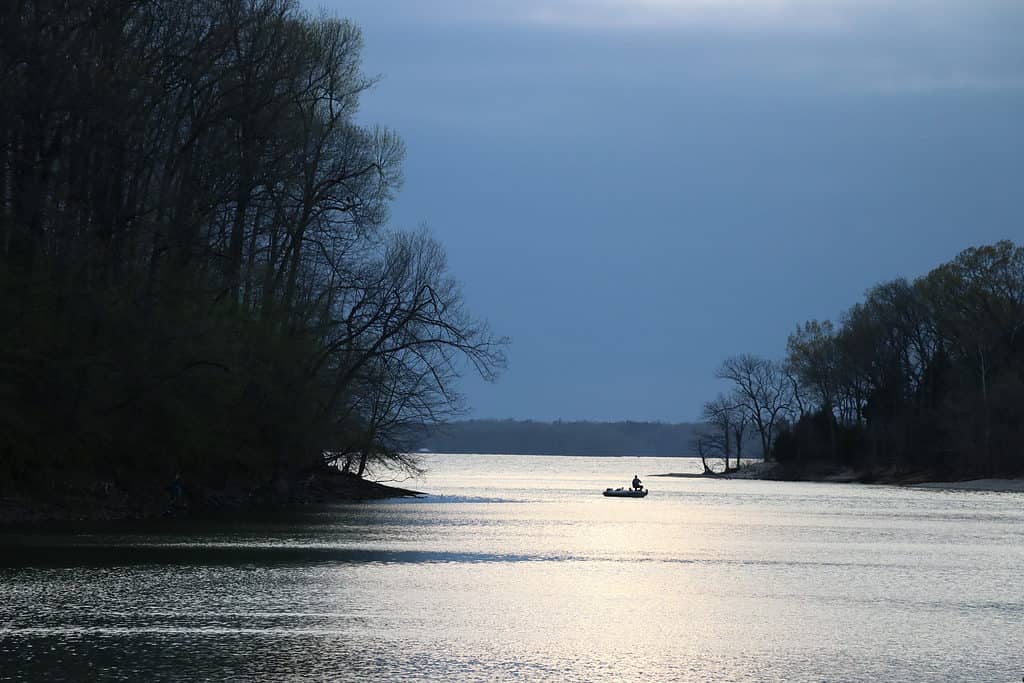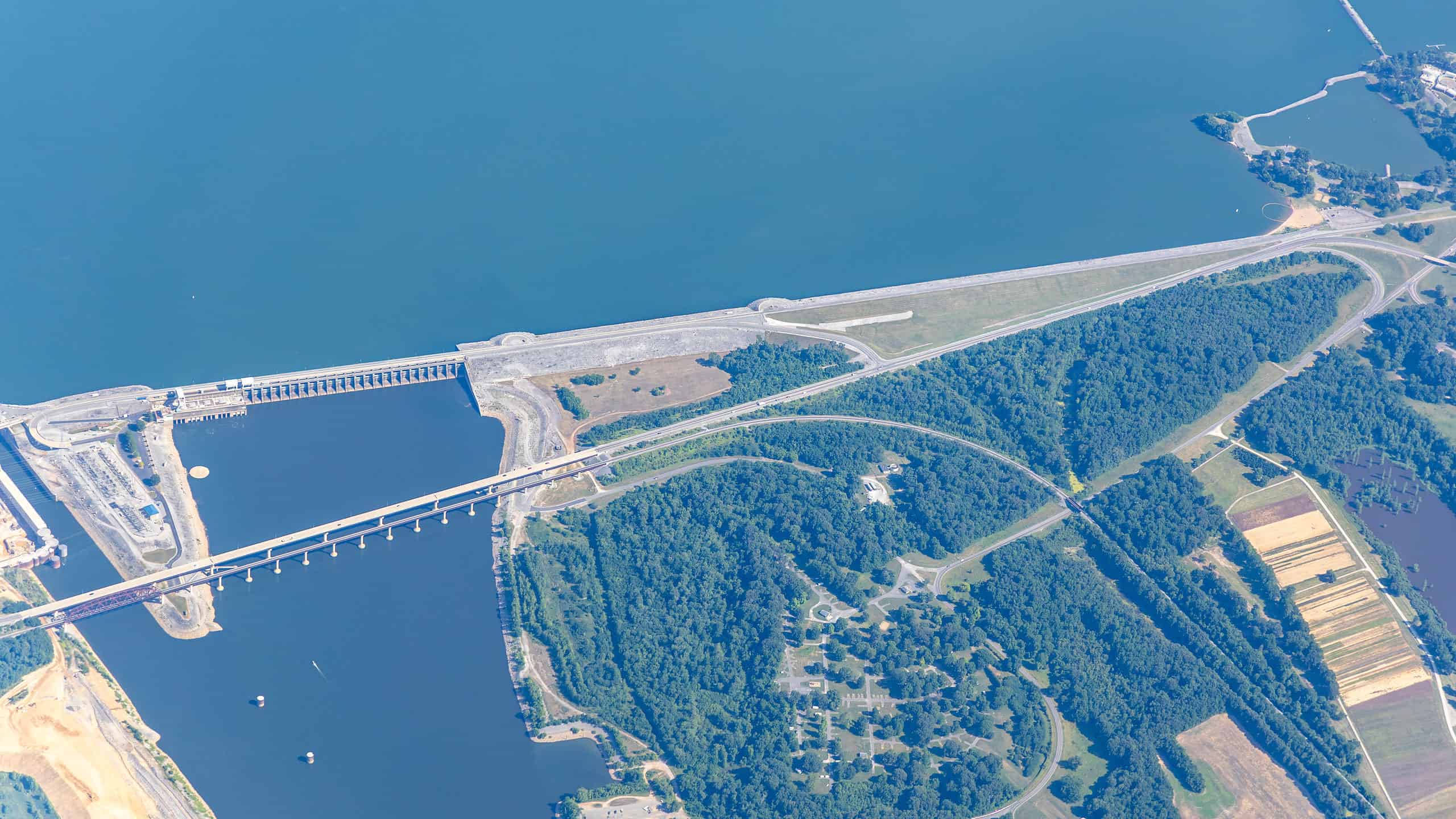
Kentucky Lake is the largest artificial lake in Tennessee. In 1944, the Tennessee Valley Authority (TVA) created it by constructing the Kentucky Dam near Gilbertsville, Kentucky, on the Tennessee River.
The lake extends to Pickwick Dam near Pickwick, TN. These two Dams are about 184 miles apart, creating the vast 160,309 acres of surface area on the lake. This fact makes it the largest in the Eastern United States. Plus, it is also the 7th largest man-made lake in the country.
How the Lake Was Created
The TVA was formed as a federal agency in May 1933. Simply put, its purpose was to study and develop the Tennessee River and its tributaries. At the time, farming, deforestation, and flooding had eroded areas around the river. 1933 was also at the height of the depression, and the TVA created many much-needed jobs for the area. The TVA’s main early focus was building dams along the river for flood control, which created reservoirs. Some dams were hydroelectric, generating electricity unavailable in many rural areas in the 1940s.
During World War II (1939 to 1945), electricity was in high demand for the aluminum plants. These plants made much-needed raw materials for the war effort. Both Kentucky Dam and Pickwick Dam are Hydroelectric Dams.

Kentucky Lake is the largest artificial lake in Tennessee with a surface area of 160,309 acres.
©Land Between the Lakes KY/TN / Flickr – License
Black Sunday
In December 1936 and January 1937, heavy rain, snow, and sleet were relentless in Tennessee. In January alone, 21.24 inches of rain fell. As the soil saturated, the runoff spilled into the Tennessee River and its tributaries. As the river overflowed, it flooded some of Tennessee’s most populated and industrialized areas. On January 24, 1937, known as “Black Sunday,” rivers overflowed in Tennessee and eleven other states. This event caused the worst natural disaster in American history.
In the end, it was estimated that 12,700 square miles flooded. 75,000 homes were destroyed, forcing residents to flee. 900 people were injured and 250 died. Furthermore, President Franklin D. Roosevelt issued a proclamation that stated 270,000 people had been forced to leave their homes. Plus, he promised that federal agencies would help local officials with the recovery effort.
One of the largest refugee camps was set up at the Memphis fairgrounds. Up to 60,000 people could seek shelter, food, and medical help at this location.
After the flood waters had receded the following year, the TVA announced that anyone living on the Tennessee River’s banks would have to relocate permanently. The construction of the Kentucky Dam started that same year, 1938. However, it took six years to complete and cost $118 million.
The dam is located 22 miles upstream from where the Ohio and Tennessee Rivers converge. It is 206 feet high and 8,422 feet long, making it the largest in the TVA system. The Dam houses five hydroelectric generating units with the net summer capacity to generate a dependable 223 megawatts of electricity.
In total, ten million acres of land are protected from extreme flooding by the dam, which has a flood storage capacity of over 4,000,000 acre-feet of water. When the dam was completed in 1944, the gates were closed, and the water level slowly rose to a level 55 feet higher than the original river. The dam established control of the water level and enabled year-round river navigation. The lock at the Kentucky Dam is the busiest in the eastern US.

The Kentucky Dam created Kentucky Lake, the largest lake in the state of Tennessee.
©iStock.com/Kent Raney
The Completion of the Dam
The Kentucky Dam’s opening was considered a huge accomplishment to be celebrated, especially after the great flood that preceded it. In the fall of 1945, newspapers described the dam as the “miracle of the twentieth century,” “the giant that harnesses the power of the Tennessee River,” and “a magnificent monument to man’s will over nature.” The dam was dedicated on October 10, 1945.
On this warm and sunny fall day, over 15,000 people gathered at the dam. This crowd was considered the largest crowd to ever assemble in western Kentucky. Ten thousand school children lined the streets of Paducah, Ky. President Harry Truman traveled to the dam in the convertible’s back seat. Furthermore, 15 members of Congress, the governor of Kentucky, and many others were also there.
Truman dedicated the dam “in the name of the American people who built it and to whom it belongs.” He also touted the TVA’s work in controlling flooding. Plus, he spoke about the significant contributions of electric power that the dam would generate. Even the outstanding recreational opportunities created by the lake were mentioned. He also described what could be one of the most significant advantages that the dam created – the completion of a deep-water navigable waterway from Paducah to Knoxville, TN.
In his speech, he mentioned, “The south and the Middle West of this Nation are now connected by water transportation. The benefits of this dam go not only to the Tennessee Valley. They go to Saint Paul and Minneapolis, to New Orleans and Memphis, to Saint Louis and Kansas City, to Omaha and Sioux City—to all the communities in the great Mississippi Valley that are served by our inland waterways.”
Pickwick Landing Dam is located on the south end of the reservoir. Construction on this dam began in 1934 and was completed in 1938 (not in time for the great flood in 1937). It is 113 feet high and extends across the Tennessee River for nearly a mile. It houses six hydroelectric generating units with the net summer capacity to generate a dependable 247 megawatts of electricity. When it was installed, the dam’s first generating turbine was the largest in the country and was more than 24 feet in diameter.

Kentucky Dam was completed in 1944 and was touted as the “miracle of the twentieth century.”
©The American Explorer/Shutterstock.com
Kentucky Lake Today
Kentucky Lake is a popular destination for recreational boaters and fishermen. The east side of the lake borders the Land Between the Lakes National Recreation Area and is considered the quiet side of the lake since the shoreline is undeveloped. This site offers anglers significant fishing areas with uninhabited forests and coves. Largemouth and smallmouth bass are popular in the spring, summer, and fall, as well as crappie and yellow bass. Redear sunfish and bluegill are popular as well in the spring months.
In some areas, the lake is nearly two miles wide, offering plenty of room for boaters and water skiing. The west side of the lake is more developed and offers several marinas and boat launch ramps. Many marinas have restaurants, boat rentals, cabins, and cottages to rent. Campgrounds are also plentiful along the lake, as well as many hotels and motels to choose from both on the lake and nearby.

Kentucky Lake near the Land Between the Lakes National Recreation Area offers anglers fishing areas with uninhabited forests and coves.
©Piotr Kalinowski Photos/Shutterstock.com
The Great Loop
Kentucky Lake is part of the “Great Loop,” a system of waterways that encircles the eastern portion of the United States. Adventurers with larger boats can start anywhere along the loop and visit many country areas by water. Traveling this 6,000-mile loop is a once-in-a-lifetime opportunity that can be done in as little as two months. However, due to the seasons, most prefer to travel to the southern states in the winter and the northern states in the summer, taking one year to complete the loop.
Starting near Grafton, Illinois, where the Illinois and Mississippi Rivers converge, you can travel down the Mississippi River to the mouth of the Ohio River. Since there are not many marinas down the southern part of the Mississippi River, many choose to take the Ohio River to the Tennessee River, across Kentucky Lake, and then down the lower Tombigbee River system that ends in Mobile, Alabama.
From there, you can traverse the Intercoastal Waterway (ICW) across the Florida Panhandle, southern Florida, and Lake Okeechobee. The ICW continues to the Chesapeake Bay, where you continue across Delaware Bay to Cape May, New Jersey. From there, you continue to New York City, enter the Hudson River, and travel through the Erie Canal to the Great Lakes. Furthermore, you can take multiple paths across the Great Lakes before eventually reaching Chicago and the Chicago River, which leads back to the Illinois River.
Where is the Largest Artificial Lake in Tennessee Located on a Map?
Kentucky Lake is located on the Tennessee River on the Kentucky and Tennessee border. Paris Landing is the closest town in Tennessee near the Lake which offers a marina and popular fishing spots.
The photo featured at the top of this post is © Norm Lane/Shutterstock.com
Sources
- Tennessee Valley Authority, Available here: https://www.tva.com/about-tva/our-history/built-for-the-people/tva-s-mightiest-dam
Thank you for reading! Have some feedback for us? Contact the AZ Animals editorial team.






